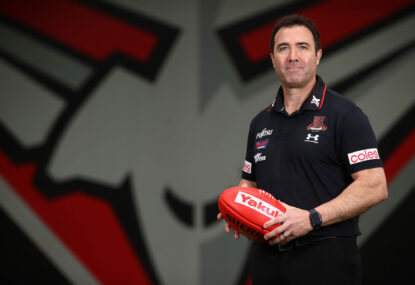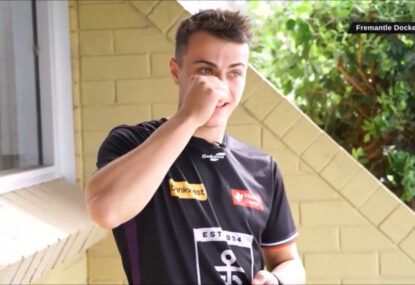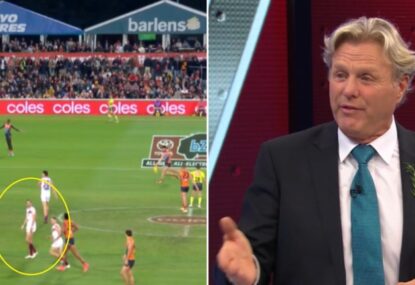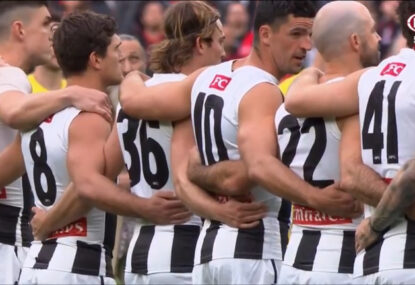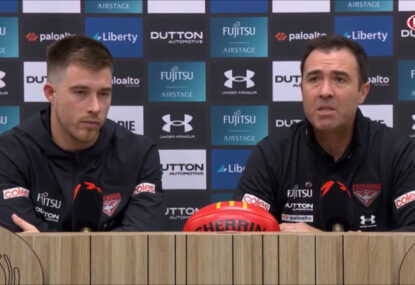I guess this means Fremantle are the best team in the competition, right?
I mean, they’re the only ones that are undefeated, having beaten Collingwood at home on the weekend. Should we all just now bow down to the superiority of the Dockers?
As they say in the classics, yeah-nah. The Dockers got lucky. The umpires had a little bit to do with it, but I don’t like whining about the umpires as it’s usually a substitute for actual knowledge about the game – though it must be said Round 3 was about the worst umpired round of the AFLW I’ve ever seen, and that’s saying something.
Mostly it’s that the Magpies dominated the Dockers for the entire first half, finished the game with 237 disposals to 144, 65 per cent disposal efficiency to 52 per cent, and had 34 inside 50s to 21. They weren’t even that far behind on efficiency inside 50, at 41 per cent to 52 per cent.
They still managed to lose, however, because of this frustrating phenomenon that sometimes happens in the AFL and always happens in the AFLW whereby all the play gets clustered down one end of the field as the dominant team locks the ball in their forward 50 and gets chance after chance that they can’t score from because the entire opposition is packed into the backline.
Then with one fast break the ball’s down the other end for a wide-open shot at goal, allowing the team that was getting smashed to somehow get ahead. Add to this that most of Fremantle’s goals came as a direct result of free kicks, at least a couple of which were questionable, and Collingwood are the better team regardless of the result.
Or, to put it more precisely, Collingwood play the style of game most likely at its very best to win premierships. They just need to get it working properly, and it’s no surprise that they haven’t done it yet as they’ve been playing this way under Steve Symmonds for only three regular-season games so far.
The Magpies ball movement against the Dockers in the first half was the best the AFLW has seen since last year’s Adelaide Crows – crisp chains of one-touch handpassing and diagonal kicking with rarely a fumble and lots of hard running. If they can just figure out their forward 50 entries a bit better and where to put the ball when the opposition has all 16 players in their back 50, which will be often against Collingwood this season, then by the time finals roll around the Pies could be looking pretty scary.
Having said all that, Fremantle’s defence is tremendous, particularly as they don’t have Alex Williams back from last season’s ACL yet. And yes, credit goes to Fremantle for kicking long and direct and not fiddling around with it – one reason their disposal count was so much lower. They simply don’t need as many possessions for each inside 50, which is one of the things that makes them so dangerous – the can be smothered all game and get very limited chances but still end up winning because their attack needs only a few chances to beat the opposition.
A note about Kiara Bowers’s crazy tackle numbers. She had 14, plus 13 disposals against Collingwood, continuing a trend of games where she has more tackles than disposals. Bowers this season is basically playing as a tagger, expecting her team to lose the hit-outs – it’s been Fremantle’s lot since forever – and playing just behind her direct opponent, waiting for her to get the ball and flattening her a split-second later.
In the AFL a high-quality tagger would get seriously roughed up, particularly when he makes a habit of hurting the best opposing midfielders. Thus far the AFLW has been too polite to resort to these tactics despite the punishment Bowers routinely hands out to others. At some point this will change.
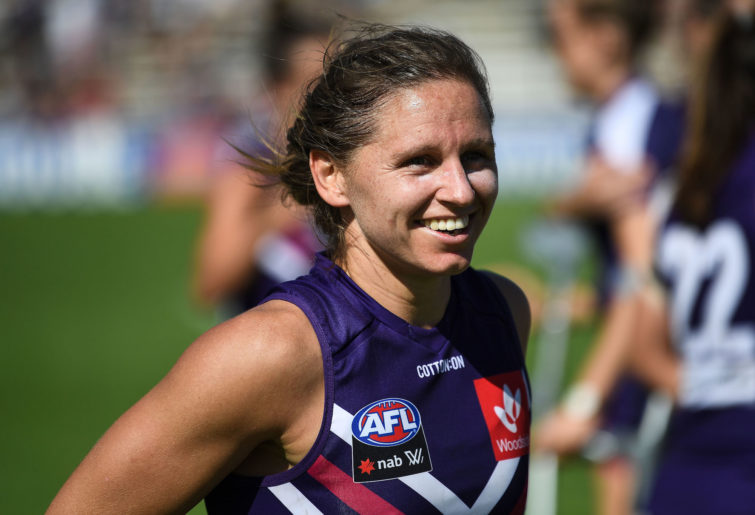
(Daniel Carson/AFL Photos via Getty Images)
Expansion teams
For all the talk about this year’s struggling expansion teams, it needs to be pointed out that only two of those teams are truly struggling. Those two get a lot of attention because they’re the biggest two: Richmond and West Coast.
The plucky Saints and Suns, on the other hand, are doing fine. Lauren Bella helped the Suns to club the Lions in the hit-outs 28 to 10, which translated into a 20 to 15 win in clearances – not bad for a team most, including me, thought would struggle in the midfield against one of the competition’s best midfields, Brisbane.
We already knew Jamie Stanton was excellent, but Hannah Dunn in the middle has been a revelation with 13 disposals and nearly seven tackles per game, youngsters Jacqui Yorston and Ellie Hampson have been solid. Then in the backline the six-foot Lauren Ahrens is averaging 15 disposals a game and livewire Kate Surman in the forward line is averaging 11 touches, but that’s gone from five in Round 1 to 16 against the Lions, meaning that Surman, like many of the Suns, is improving fast with experience at the top level.
The Suns lacked some of Brisbane’s fluency with the ball but made up for it with hard, contested possession and sheer toughness, fighting back from a first-half deficit to draw the game. They lack some of the polish of the more established teams, but that’s to be expected given their respective lists.
What they seem to have in common with fellow high-achieving expansion team St Kilda – and what Richmond and West Coast notably lack – is a wide spread of contributors across the ground. This surprising depth – though probably only surprising to people outside of Queensland – plus the surge of new talent coming through Gold Coast’s junior development programs could see the Suns become the immediate threat in the AFLW that they’ve always dreamed of being in the AFL.
Speaking of the Saints, they were phenomenal against Melbourne. Yes, the Demons were horribly inaccurate with 1.8, but the young Saints applied huge pressure against Melbourne’s vaunted midfield, breaking even in clearances with 21 each, forcing more turnovers from their more highly rated opponents 58 to 52 and collecting 214 disposals to 215. They got some breaks before goals, while the Demons got none, but it wasn’t like that was the only factor that decided the game.
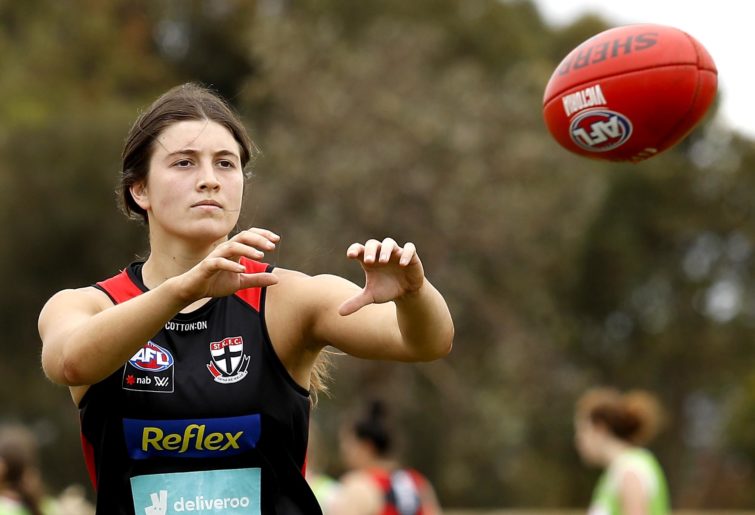
(Dylan Burns/AFL Photos via Getty Images)
Like the Suns, the Saints spread of contributors was impressive, with 12 players accumulating double-figure disposals, and one of them, Caitlin Greiser, suggesting she could be a star of the future with two goals to go with her 11 possessions, including a game-winning 50-plus-metre monster in the last quarter. In Round 3 the Suns had 11 players in double figures, whereas the Eagles had only six against the Giants and the Tigers had five against North Melbourne.
Depth counts for a lot in women’s football. While the men can move the ball from end to end with just two or three kicks, the women require far more. Thus chains of possession need to go through far more hands to successfully move the ball from defence to offence. When the talent in a team is wildly imbalanced between the team’s best and worst players, chains of possession break down and those teams will rarely succeed in moving the ball into attack because some players along the way will simply spray it or drop it or do something else to break the chain.
Simple maths tells you why this is happening far more to the Eagles and Tigers right now than it is to the Suns and Saints. A few stars looming high above the rest just won’t get it done anymore. The established AFLW teams are now approaching a level where there are no mediocre players on their lists. Obviously some players will always be better than others, but even the weakest player on the field for teams like Collingwood, Fremantle, Carlton or Melbourne are now at least fairly good.
For St Kilda to match Melbourne as closely as the stats demonstrate in just their third game of AFLW footy is not just a testament to the talent and determination of the players but to the recruiting nous of the Saints’ coaching staff, who have somehow managed to assemble a team with perhaps just one obvious star (Georgia Patrikios) but with even fewer weak links. Like the Suns, another year or two of picks from the talented drafts on the way and the Saints could be as good as anyone.
Don’t underestimate Adelaide
Sure, they only beat Geelong, but this was the best performance from Geelong we’ve seen so far, and the Crows are quietly getting their strength back.
For one thing, some of the players they brought in to replace their injured stars have started to perform, like 25-year-old Najwa Allen from the SANFLW, with a breakout 19 possessions or 21-year-old Chelsea Biddell, with a powerful forward’s build and two goals. The 25-year-old Justine Mules also continues to improve with every season and had 17 disposals here.
When this team starts to play well they just seem to find a way. Despite scoring 49 points – large by AFL standards – the Crows were actually inefficient in forward 50 entries, getting a score from only ten of 43 inside 50s. Their deadly accuracy from those ten was largely due to 19-year-old Danielle Ponter, who is in the process of turning herself into one of the competition’s most dangerous forwards, having added some real physical conditioning to her eye-wateringly good one-touch skills.
In this game the Crows got the previously injured Courtney Cramey back. She had only five disposals in the backline but looked solid, and the backline looked better for her inclusion. In weeks ahead the Crows could be seeing the return of Deni Varnhagen, Chloe Scheer and of course Erin Phillips. Their form each week is lifting, their list is improving, and they only need to grab the last available finals spot with their fingernails to get in and do some serious damage while they’re there.
Next week, however, they get a real test in Carlton. As improved as the Crows look, my money’s still on the Blues.































































































